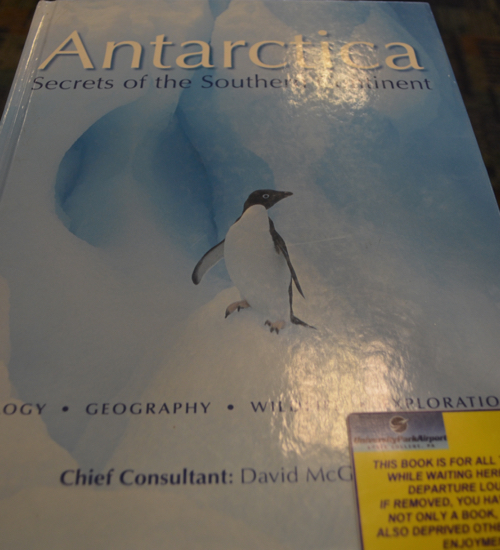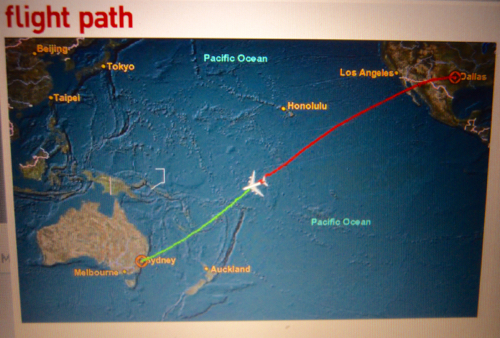From State College to Christchurch
My journey to Antarctica started yesterday morning at the quaint airport in State College, Pennsylvania. As I waited to board a small plane to Philadelphia, I looked through a library of sorts in the waiting area and came across a fortuitous book about Antarctica. As I looked through pages about past expeditions, I wondered if past Antarctic explorers felt as giddy and anxious as me.
 The State College airport has an Antarctica book in its library.
The State College airport has an Antarctica book in its library.
Flying over the valleys and mountains of central Pennsylvania, I soaked in the colors: oranges, yellows, deep and vibrant reds. Soon I will see mostly white and brown.
 The view from the airplane overlooking central Pennsylvania shows fall colors.
The view from the airplane overlooking central Pennsylvania shows fall colors.
After flying to Dallas, I met the rest of my research team. We are now flying to Sydney. After a 12 hour layover in Sydney, we will fly on to ChristChurch, New Zealand, where we will stay for a few days before the final flight to McMurdo Station. Not including layovers, it will take me about 30 hours to fly to Antarctica.
A Rich History
I will be traveling to McMurdo Station, which sits on the edge of Ross Island, off the coast of Antarctica.
 McMurdo Station is located on Ross Island.
McMurdo Station is located on Ross Island.
It is appropriate that my research team is monitoring the environment of McMurdo Station--Ross Island has a rich history of visits and exploration, more so than anywhere else on the continent. The island is named after James Clark Ross, who sighted it in 1841. However it wasn't until 1902 that the island was visited by Robert Falcon Scott and his team in the Discovery Expedition.
 Robert Falcon Scott at Cape Evans in 1911.
Robert Falcon Scott at Cape Evans in 1911.
With Technology Comes Speed
 An in-flight map shows the long flight from Dallas to Syndey.
An in-flight map shows the long flight from Dallas to Syndey.
I am watching a small plane icon on the screen in front of my airplane seat creep closer and closer to Sydney. Although I will spend a long time on airplanes to reach Antarctica, it is nowhere near the length of time Scott took to get there. Scott and his team left London on July 31, 1901 on a ship named Discovery. It took months to arrive in New Zealand, where they collected food and other supplies.
 The Discovery Ship anchored to the ice in Antarctica.
The Discovery Ship anchored to the ice in Antarctica.
Before arriving in Antarctica, Scott and his team had to stop in Port Chalmers, New Zealand to bury a seaman who had fallen from the mainmast. Scott also went up in a hydrogen air balloon to preview the coastline and find a suitable landing spot. On January 21, 1902 Scott and his crew entered McMurdo Sound and by February 2 they settled in Winter Quarters Bay, close to where McMurdo Station is today. Although it will take me about four days to finally arrive at McMurdo Station, it took Scott and his crew 187 days to make the journey. I guess I can't complain.
Math Connection
How many times faster am I than Scott's Discovery Expedition in arriving at McMurdo Station?
Critical Thinking
The plane we took from Dallas to Sydney was huge! Our 16+ hour trip was also the longest commercial flight in the world! On the way to Sydney, the airplane is required to leave 100 empty seats. However, this is not required on the way back. Why do you think that is?
Record your answer in the "Ask the Team" section of the journal. I'll post answers in the next journal!
Ice POD
Today's ice POD is about Robert Falcon Scott:
2_icepod_scott_history_of_antarctica.pptx
 Ice Picture of the Day showing Scott.
Ice Picture of the Day showing Scott.
Comments